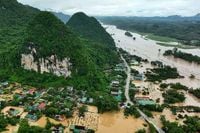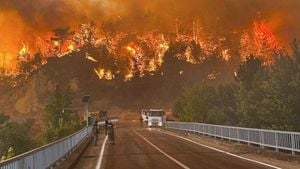Tropical Storm Wipha swept across northern Vietnam and parts of Southeast Asia in July 2025, leaving a trail of destruction, displacement, and heartbreak. The storm, which made landfall on July 22, battered provinces with heavy rains, fierce winds, and widespread flooding, triggering landslides and isolating communities. While it weakened into a tropical depression shortly after touching down, the damage was severe, with at least one confirmed death, multiple injuries, and hundreds of families forced to evacuate amid rising waters and power outages.
In Vietnam's north-central Nghe An province, the storm's effects were especially devastating. A 59-year-old man tragically lost his life on July 20 when a tree fell on his house just before Wipha's arrival, according to local police reports. The province, stretching from the South China Sea coast to the mountainous border with Laos, endured some of the heaviest rains and flooding. Another woman was swept away by floodwaters and remains missing, while four others sustained injuries. The floods damaged hundreds of homes, destroyed crops, and cut off remote communities, leaving several upland areas isolated without electricity or communication.
Authorities evacuated nearly 400 households from landslide-prone zones to safer areas as landslides damaged roads and partially collapsed a school building. The Ban Ve hydropower plant, the largest in the region, had to release water from its reservoir to manage the floodwaters, which in some places rose to the rooftops of homes overnight. Resident Nguyen Thai Hung described the flooding as unprecedented, saying, "Water levels this year were much higher and more terrible than what we considered a historic flooding in 1988. We really don’t know what to do as the water has reached the top of our houses." More than 200 families in Yen Hoa commune were cut off after flash floods damaged the main access route to their village.
Wipha made landfall with sustained winds reaching up to 102 kilometers per hour (63 mph) but quickly weakened as it moved inland. The storm caused widespread power outages and disrupted farming operations across northern provinces. Several airports temporarily closed, and emergency services were on high alert. In preparation for the storm, about 12,500 people were evacuated from high-risk areas over the weekend before Wipha’s arrival. Additionally, around 350,000 soldiers were put on standby nationwide to assist with emergency response efforts.
The storm's impact was not confined to Vietnam. In neighboring Thailand, heavy rains triggered flooding in several northern provinces from the night of July 22 into July 23, affecting more than 350 people. Authorities reported no casualties but warned residents to remain vigilant against flash floods and landslides. The swollen rivers inundated homes and disrupted daily life, reflecting the broader regional effects of Wipha’s passage.
Meanwhile, the Philippines grappled with intensified monsoon rains exacerbated by Wipha. The relentless downpours caused knee- to waist-deep flooding across northern regions, forcing a second day of school closures, flight cancellations, and suspension of government work. Thousands of families remained in evacuation centers as the heavy rains persisted. In a poignant scene amid the floods, newlyweds Jade Rick Verdillo and Jamaica Aguilar held their wedding ceremony on July 22 inside the Barasoain Church in Malolos, Bulacan province, despite the water rising nearly to their knees. Verdillo reflected on their decision to proceed, saying, "We just mustered enough courage. We decided today because it is a sacrifice in itself. But there will be more sacrifices if we don't push through today." Their determination symbolized resilience in the face of adversity, with friends and family witnessing a wedding that defied the storm.
Vietnam’s vulnerability to typhoons and tropical storms is well-known, given its long coastline along the South China Sea. Wipha was the first major storm to hit the country in 2025, serving as a stark reminder of the dangers posed by extreme weather. Just last year, Typhoon Yagi devastated northern Vietnam, killing an estimated 300 people and causing $3.3 billion in damages. Experts link the increasing intensity and frequency of such storms to human-driven climate change, which disrupts weather patterns and raises the likelihood of destructive floods and landslides.
The government and emergency agencies have been working to strengthen preparedness and response to these natural disasters. Prime Minister Pham Minh Chinh placed coastal provinces on emergency footing as Wipha approached, mobilizing resources to protect lives and property. Despite these efforts, the storm’s aftermath underscores the ongoing challenges faced by communities in the region, particularly those in rural and mountainous areas where infrastructure can be fragile.
As the waters recede and recovery begins, the human toll and economic impact of Tropical Storm Wipha continue to unfold. The loss of life, displacement of thousands, and destruction of homes and crops highlight the urgent need for enhanced disaster resilience and climate adaptation strategies. For now, the people of Vietnam, Thailand, and the Philippines are left to rebuild and reflect on the powerful forces of nature that shaped their summer of 2025.





